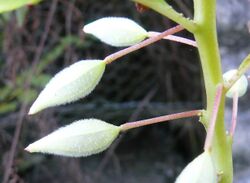Biology:Impatiens balsamina
| Impatiens balsamina | |
|---|---|

| |
| Scientific classification | |
| Kingdom: | Plantae |
| Clade: | Tracheophytes |
| Clade: | Angiosperms |
| Clade: | Eudicots |
| Clade: | Asterids |
| Order: | Ericales |
| Family: | Balsaminaceae |
| Genus: | Impatiens |
| Species: | I. balsamina
|
| Binomial name | |
| Impatiens balsamina | |
Impatiens balsamina, commonly known as balsam, garden balsam, rose balsam, touch-me-not[1] or spotted snapweed,[2] is a species of plant native to India and Myanmar.[1]
It is an annual plant growing to 20–75 cm tall, with a thick, but soft stem. The leaves are spirally-arranged, 2.5–9 cm long and 1–2.5 cm broad, with a deeply toothed margin. The flowers are pink, red, mauve, purple, lilac, or white, and 2.5–5 cm diameter; they are pollinated by bees and other insects, and also by nectar-feeding birds.[3] The ripe seed capsules undergo explosive dehiscence.[4]
Human use
Different parts of the plant are used as traditional remedies for disease and skin afflictions. Juice from the leaves is used to treat warts and snakebite, and the flower is applied to burns.[5] This species has been used as indigenous traditional medicine in Asia for rheumatism, fractures, and other ailments.[6] In Korean folk medicine, this impatiens species is used as a medicine called bongseonhwa dae (봉선화대) for the treatment of constipation and gastritis.[7] Chinese people used the plant to treat those bitten by snakes or who ingested poisonous fish.[8] Juice from the stalk, pulverised dried stalks, and pastes from the flowers were also used to treat a variety of ailments.[8] Vietnamese wash their hair with an extract of the plant to stimulate hair growth.[8] One in vitro study found extracts of this impatiens species, especially of the seed pod, to be active against antibiotic-resistant strains of Helicobacter pylori.[6] It is also an inhibitor of 5α-reductases, enzymes that converts testosterone to dihydrotestosterone (active form of testosterone), thus reducing action of testosterone in our body.[9]
In Nepal, the balsam leaves are crushed to dye fingernails on the day of Shrawan Sakranti (Shrawan 1). The day is also observed as Luto Faalne Deen (Go Away-Itch Day). Similarly, in China and Korea, the flowers are crushed and mixed with alum to produce an orange dye that can be used to dye fingernails. Unlike common nail varnish, the dye is semi-permanent, requiring dyed nails to grow off over time in order to remove any traces of color.[10][11]
Chemistry
The naphthoquinones lawsone, or hennotannic acid, and lawsone methyl ether and methylene-3,3'-bilawsone are some of the active compounds in I. balsamina leaves.[12] It also contains kaempferol and several derivatives.[13] Baccharane glycosides have been found in Chinese herbal remedies made from the seeds.[14]
Ecology
It is widely cultivated as an ornamental plant, and has become naturalised and invasive on several Pacific Ocean islands.[4]
In popular culture
The Japanese vocaloid song Housenka (鳳仙花, which translates to Impatiens Balsamina) describes a person who doesn't fit in with a social group despite wanting to.[15] In the music video, the singer laments this fate and compares herself to the plant. She references its "touch-me-not" nickname and the Hedgehog's Dilemma-esque explosive dehiscence of its seeds by saying:
"Don't touch me," the balsam [says], fallen silent. And yet it can't leave seeds unless it breaks from its shell.[15]
Gallery
Saplings of Impatiens balsamina. The cotyledons are visible.
References
- ↑ 1.0 1.1 {{citation | mode = cs1 | title = Impatiens balsamina | work = Germplasm Resources Information Network (GRIN) | url = | publisher = [[Organization:Agricultural Research ServAgricultural Research Service (ARS), United States Department of Agriculture (USDA) | access-date = 20 April 2019 }}
- ↑ "Impatiens balsamina". Natural Resources Conservation Service PLANTS Database. USDA. https://plants.usda.gov/core/profile?symbol=IMBA.
- ↑ Huxley, A., ed. (1992). New RHS Dictionary of Gardening. Macmillan ISBN:0-333-47494-5.
- ↑ 4.0 4.1 Impatiens balsamina. Pacific Island Ecosystems at Risk (PIER).
- ↑ Plants for a Future: Impatiens balsamina
- ↑ 6.0 6.1 "In vitro activity of Impatiens balsamina L. against multiple antibiotic-resistant Helicobacter pylori". Am. J. Chin. Med. 37 (4): 713–22. 2009. doi:10.1142/S0192415X09007181. PMID 19655409.
- ↑ "Pharmacognostical studies on the folk medicine bong seon wha dae". Korean Journal of Pharmacognosy 34 (3): 193–96. 2003. http://agris.fao.org/agris-search/search/display.do?f=2004/KR/KR04009.xml;KR2004004760.
- ↑ 8.0 8.1 8.2 Christopher Cumo. "Impatiens". Encyclopedia of Cultivated Plants: From Acacia to Zinnia. Christopher Cumo, ed. ABC-CLIO, 2013. p. 523. ISBN:9781598847758
- ↑ "Testosterone 5α-reductase inhibitor bisnaphthoquinone derivative from Impatiens balsamina". Phytother Res 14 (1): 54–6. February 2000. doi:10.1002/(SICI)1099-1573(200002)14:1<54::AID-PTR540>3.0.CO;2-Q. PMID 10641051.
- ↑ "Naturally dyed red nails". JoongAng Daily. 12 September 2004. http://joongangdaily.joins.com/article/view.asp?aid=2468075.
- ↑ "Summer, the Way It Used to Be...". The Korea Times. 16 June 2008. http://www.koreatimes.co.kr/www/news/art/2008/06/203_25800.html.
- ↑ "Simultaneous determination of three naphthoquinones in the leaves of Impatiens balsamina L. by reversed-phase high-performance liquid chromatography". Phytochem Anal 21 (5): 444–50. 2010. doi:10.1002/pca.1216. PMID 20931623.
- ↑ "Separation of kaempferols in Impatiens balsamina flowers by capillary electrophoresis with electrochemical detection". J Chromatogr A 909 (2): 297–303. February 2001. doi:10.1016/S0021-9673(00)01102-X. PMID 11269529.
- ↑ "Simultaneous qualification and quantification of baccharane glycosides in Impatientis Semen by HPLC–ESI-MSD and HPLC–ELSD". J Pharm Biomed Anal 54 (4): 674–80. March 2011. doi:10.1016/j.jpba.2010.10.014. PMID 21075577.
- ↑ 15.0 15.1 (in ja) 【Yuzuki Yukari】Balsam【Original】, 2013-07-31, https://www.nicovideo.jp/watch/sm21479692, retrieved 2022-05-30
External links
- Jewelweeds. Drugs.com
Wikidata ☰ Q845019 entry
 |
















